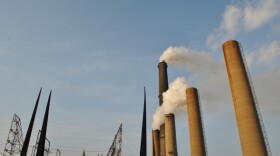A Louisville Catholic school will be the site of a new air pollution experiment, as researchers at the University of Louisville study whether trees and greenery can reduce pollution from a nearby roadway.
St. Margaret Mary School is located on Shelbyville Road, right across from Oxmoor Mall. It’s a busy road, and during peak times, cars often back up and idle at traffic lights.
It’s known that trees and greenery help reduce some types of air pollution — and that reducing such pollution has some health benefits. But this summer, University of Louisville researchers will begin testing whether adding a vegetative buffer at St. Margaret Mary will have a measurable effect on the pollution on school grounds.
“People appreciate trees and they’re good and they’re aesthetically pleasing, but whether they actually have specific quantifiable health-promoting effects by removing pollutants from air has never been rigorously tested,” said Aruni Bhatnagar, the director of U of L’s Diabetes and Obesity Center.
The research is a collaboration between the Institute for Healthy Air, Water and Soil, Louisville Metro Government’s Office of Sustainability and U of L. Air monitoring will begin this summer.
Bhatnagar said previous research around the country has largely focused on comparing leafier neighborhoods with other, comparable neighborhoods, rather than taking one location and testing the effects of increasing its greenery. The monitors will test for both particle pollution and certain volatile organic compounds linked to vehicle exhaust.
Sometime this fall, after several months of monitoring, Bhatnagar’s team will plant a “green screen” of 15-20-foot-tall trees and bushes, buffering parts of the school’s campus from Shelbyville Road. Monitoring will continue through the next year or so.
St. Margaret Mary School Principal Wendy Sims said students will be involved in the monitoring and will use the space as an outdoor classroom. She said eventually, the school will decide whether to continue the vegetative screen across the entire lawn.
“If we decide that this is very beneficial for our families and the building itself, we can continue planting on the other side,” she said.
Bhatnagar said the research should show whether there’s measurable data to back up the idea that plants help shield from air pollution in a given space. It also might provide information about what types of trees and planting density is most effective. But he said enlisting St. Margaret Mary students to help with the experiment is an added benefit.
“One particular outcome we are assured of is that we would pique the interest of the students and get them involved in this as a scientific experiment to develop citizen scientists of the future,” he said.
Bhatnagar said eventually, he’d like to conduct the same research on a neighborhood scale. Working with students has limited possibilities for examining some of the health issues that plague adults, he said. And later, he’d like to examine disease outcomes and their relationship to trees in a single neighborhood.





